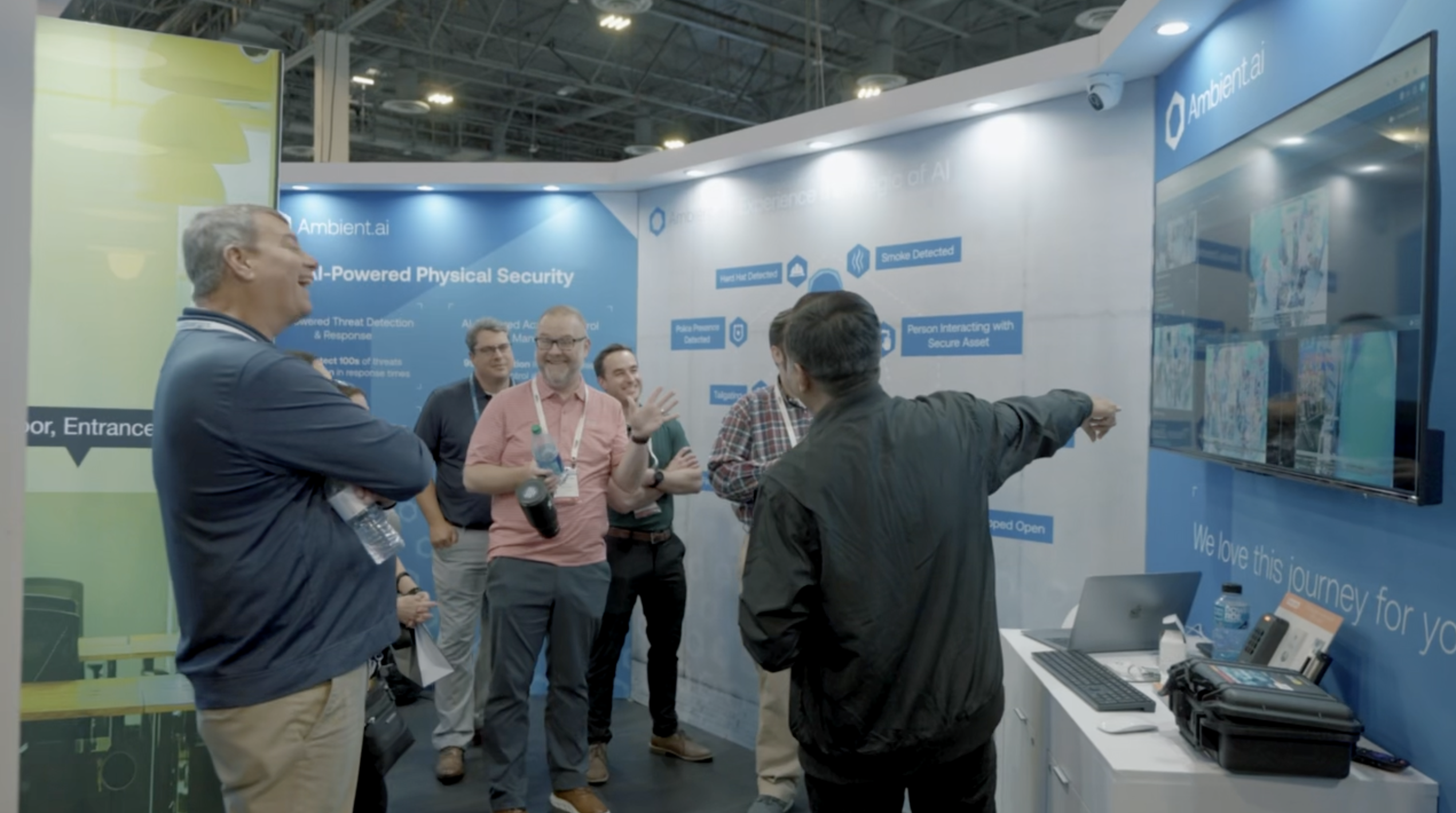Here’s the truth: physical security needs to change how it talks about AI.
From reduced risk to improved resource allocation, today’s security teams can now generate high-impact, business-critical results thanks to AI systems. Yet conversations on AI often veer into two extremes: they either alienate audiences with technical jargon, or get lost in grandiose claims that lack substance (“AI changes the game”).
The fact is that framing real, powerful technology with buzzwords and inflated declarations benefits no one. It simply fuels the misconception that AI is just overblown hype, confuses security decision-makers, and blocks potential end users from reaping its benefits.
It’s time for a paradigm shift in how the industry talks about AI. We need more productive conversations on the actual, concrete value and ROI of this exceptional technology.
So, we’re not here to tell you that AI will “transform your team’s operations” and then just leave it at that. In this article, we want to cut through the smoke and mirrors. Here’s our no-fluff take on the big question:
What can AI do for you?
Table of Contents
- Why AI is the answer to today’s security challenges
- What makes AI-powered computer vision intelligence different?
- What can AI do for me?
- The best way forward for AI in physical security
Why AI is the answer to today’s security challenges
Too much to monitor. Too much wasted time. Limited insights. Limited resources.
Sound familiar? For far too many physical security teams, the industry appears marred by excess and limitations.
It’s clear that traditional security systems aren’t equipped to address these challenges. With legacy technologies, these are the risks that organizations (perhaps even your own) take:
- 95%+ of security video footage goes unmonitored
- For every 500 doors, 8K+ hours are wasted clearing false alarms each year
- For every 100K square feet of space, $1M+ is spent on guards with limited awareness of activities
These difficulties are baked into the experiences of countless security teams, but with AI, they do not have to be the reality.
We’ve seen various AI solutions on the market in recent years, yet no tool compares to AI-powered computer vision intelligence. Security teams that use this technology have tackled their long-standing challenges by reducing risk, streamlining operations, and gaining valuable insights.
What makes AI-powered computer vision intelligence different?
CVI understands contextualized activity and contrasts it with the normal patterns of life. It comprehends that a person wielding a knife in the lobby is a potential threat, while a person wielding a knife in the kitchen is a routine occurrence. This reduces false positives and allows your security team to focus on genuine threats in a way that video analytics solutions can’t.
Perhaps you want your security system to alert you to after-hours disturbances. If a group of people gathered at your company’s entrance in the middle of the night, a CVI-enabled system would recognize this as an anomaly compared to usual foot traffic and send a notification.
Leading-edge AI acts as a powerful tool to enhance security postures.
But we still need to answer the big question…
What can AI do for me?
Here’s our straightforward, no-nonsense answer to how AI works for you — in many more ways than one:
You have too many cameras to monitor and not enough people to monitor them…
It’s the age-old question in physical security: Who’s going to watch all of these cameras? Most surveillance video isn’t monitored live, and most isn’t reviewed after the fact, either. It’s a major security risk that too many companies take.
Even if your cameras are actively monitored, how many incidents have gone undetected? How many incidents could have been avoided if the early warning signs were spotted on the surveillance feeds?
That’s where AI comes in.
AI-powered CVI continuously monitors your cameras for deviations from the norm, eliminating the possibility of human oversight. In doing so, the AI is able to catch early warning signs of threats, like tailgating or loitering, and prevent them from escalating into full-blown incidents.
Through these capabilities, your team can finally make one of the most consequential changes to their security posture: shifting from a reactive to a proactive stance. This approach emphasizes preventing and mitigating threats, rather than reacting to incidents after the damage has already been done.
Take the SentinelOne corporate security function, for instance. With a small team of just three people, SentinelOne uses Ambient.ai to closely monitor their global sites and gain a complete understanding of their threat environment.
You have limited insights into your operations and risk profile…
Do you have data that supports why your guards are positioned where they are? What about insights on how you can improve camera deployment, or where access control needs improvement?
If you don’t have solid data on which to build policies and procedures, you’re flying blind. Unfortunately, with traditional tools, most security teams find themselves in this position.
That’s where AI comes in.
While AI monitors video feeds and verifies alarms, it simultaneously analyzes mass amounts of data on your security posture and environment. The result is hundreds of critical insights that your team can use to evaluate the impact of your operations.
For Tor Warmdahl, Director of Security at The Harker School, leveraging AI allowed a more data-driven approach to protecting students, faculty, and staff.
“We can use that data to say, ‘Okay, how can we make this area a harder target?’ or you can take that data and dispatch your team or utilize your resources to address alerts in real-time,” said Tor.
Ambient.ai’s insights into The Harker School’s risk profile and context on incidents provide Tor with one of the most critical components of a strong security posture: full site awareness. As a bonus, he’s also used the analytics to advocate for additional security personnel and resources.
You’re grappling with false alerts and alarm fatigue…
How do you prioritize legitimate access control threats when you’re constantly inundated with false alarms? And how can you possibly make room for high-priority, strategic tasks when you spend all of your time clearing nuisance alarms?
For many security teams, these questions remain unanswered. What’s clear is that the current state of alarm management is unsustainable for operators and increases the chance of missing genuine incidents.
That’s where AI comes in.
Once an AI platform is integrated with your existing security cameras and access control system, data flows from these technologies to the AI-powered “brain.” From here, the AI correlates PACS alerts and security camera footage to auto-acknowledge and clear the thousands of low-priority alarms that operators receive.
With AI surfacing only the most urgent incidents, your operators can finally dedicate more time to legitimate threats and high-impact work, free from the distraction of nuisance alarms. Better yet, needing fewer man-hours and headcount for alarm management means greater cost savings and resource efficiencies.
Watch and learn for more insights into how AI manages access control alarms.
Your video investigations are slow and tedious…
Are you able to instantly access video footage when running forensic investigations? Is it easy to search through that video when you have it? With traditional systems, completing a single investigation can become incredibly time-consuming, taking hours — even days.
Cumbersome tools create inefficient operations. Often, operators must painstakingly search through one stream at a time, sifting through hours upon hours of footage, sometimes with multiple logins across various sites or appliances.
That’s where AI comes in.
Integrating AI into your surveillance system allows your team to search surveillance footage within minutes of an incident occurring, all without delays caused by video processing.
Advanced systems enable teams to filter through historical footage using keyword-based search criteria, such as a person wearing a blue shirt, to investigate incidents as easily and quickly as possible.
This Fortune 500 software company previously spent several painful days reviewing footage from multiple cameras for each video review. But once they started using Ambient.ai’s forensics capabilities, this process accelerated by 20x.
The best way forward for AI in physical security
There’s no doubt that AI has left a lasting mark on physical security. As this technology continues to dominate conversations, the best way forward is clear. The industry must cut through the hype and buzzwords to put a spotlight on the genuine value that these transformative technologies provide.
Here at Ambient.ai, we’re dedicated to helping organizations reduce risk, improve security operational efficiency, and gain critical insights through our AI-powered platform. Companies that use Ambient.ai see a 90%+ reduction in access control alarms, real-time responses to incidents, and 100% of cameras monitored 24/7.
Explore the impact that Ambient.ai’s AI physical security can have on your operations.












